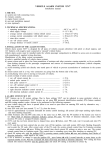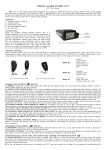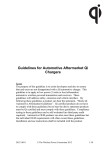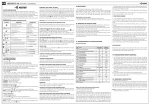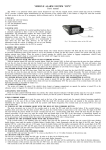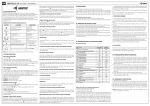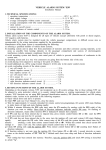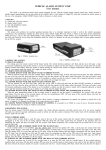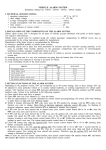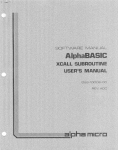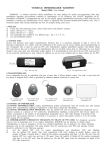Download installation manual
Transcript
VEHICLE ALARM SYSTEM 'GN6I.a' Installation manual. 1. TECHNICAL SPECIFICATIONS: P operating temperature ............................................................................................... P rated supply voltage .................................................................................................. P average consumption without sensor connected ...................................................... P average consumption with US2 sensor connected .................................................. P siren drive current ..................................................................................................... P cut - off circuit current ............................................................................................... – 40°C / +85°C; 9 - 15 V DC; £ 14 mA (U=12 V); £ 20 mA (U=12 V); £ 2 A; £ 25 A. 2. INSTALLATION OF THE ALARM SYSTEM. Vehicle alarm system 'GN6I.a' is designed for all types of vehicles (except cabriolets) with petrol or diesel engines, with genuine remote control central locks and 12V batteries with negative pole connected to ”ground” (vehicle body). Vehicle alarm system must be installed inside the vehicle passenger compartment in difficult to access area in accordance with manufacturer's supplied wiring directions. Manufacturer of the alarm system recommends: a) select a qualified installer of vehicle alarm systems; b) mount system unit in place free from penetration of moisture and other corrosion - causing materials, as far as possible from heating elements in the passenger compartment and sources of electromagnetic interference (vehicle computer, fans, blocks of relays); c) avoid mounting system unit directly onto metal parts of vehicle to prevent accumulation of condensate in the system unit; d) mount system unit in a way, wire connectors are going from the bottom side of the unit; e) avoid placing wires next to moving or hot parts of vehicle; f) avoid overload of alarm system circuits: P cut - off circuit 1 current ......................................................................................... £ 25 A; P optional control circuit (OC) 8 current .................................................................. £ 0,13 A; P siren drive circuit 1 current .................................................................................... £ 2 A; P right direction indicator control 5 current ............................................................... £ 7 A; P left direction indicator control 2 current ................................................................ £ 7 A. 3. ALARM SYSTEM SET UP. 'GN6I.a' features up to 70 system settings. Due to these settings 'GN6I.a' can be adjusted to some particular vehicle or relevant customer requirements. 'GN6I.a' features are set using PIN (personal identification number), FN (feature number) and SN (setting number) codes. Actions to be performed in the following sequence: a) enter PIN code (see user manual 5.2 or 5.3); b) system LED starts flashing frequently, it is possible to close the door; c) within 8 minutes after the PIN code entry (by analogy as described in user manual 5.2 or 5.3) enter the FN number of the feature you want to set. If entered correct FN, then system indicates current SN value by 5 series of car's direction indicator flashes (with 2 second pause between series), the number of flashes in each series corresponds to current SN value. The assigned control time is extended for 8 minutes. No flash of direction indicators means either incorrect FN entry or control time elapsed; d) if FN code has not been entered due to elapsed control time, turn OFF the ignition and repeat actions starting from 3 a; e) if FN code has not been entered due an error, turn OFF the ignition, wait until system LED starts flashing frequently and re-enter the FN code; f) if SN is incorrect, to change it: during the system indicates current SN value by 5 series of direction indicator flashes turn ON the ignition or press and hold down the secret button. The direction indicators start to flash by single flashes every 3 seconds. When the number of flashes corresponds to the necessary SN value – turn OFF the ignition or release the secret button. The system confirms a new SN value entry by short siren beep and indicates new SN value by 5 series of direction indicator flashes. The control time is extended for 8 minutes; g) for adaptation of vehicle alarm system the Central Lock action sequence can be used computer learning, automatic learning or manual learning: Computer learning is advanced, but it is much more precise and reliable. =enter the PIN code if control time is elapsed; =connect GN6I.a to PC using the special adjustment device „PULSE-LATCHER”; =start CAdmin software and press the button „OSC GN6IA” on software window; =following the software instructions read out the sequences of pulses are generated on 'GN6I.a' inputs during the Central Lock is locked and unlocked; =read pulses will be displayed on computer display. According with these pulses adjust the pulse identification parameters; =after adjustment send the data to the alarm system; =these pulse parameters of the specific vehicle may be stored in a file, so in case installation of 'GN6I.a' in vehicle with the same Central Locking System it will be no need to read out the pulses. It will be enough to open stored file and send the data to 'GN6I.a'; Automatic learning is more simple (no computer is needed), but less precise and reliable because the installer has no chance to observe the processes on the alarm system inputs. =if FN=54, SN=4 is selected, the system switches to automatic learning mode. The system siren emits the series of single or double sound signals. The series are emitted alternatively, duration of series is 20 seconds; =series of single siren signals – lock the Central Lock by remote control LOCK button, wait for next series; =series of double siren signals – unlock the Central Lock by remote control UNLOCK button, wait for next series; =according with series of siren signals repeat locking and unlocking of Central Lock once again; =during automatic learning the system memorizes the processes running in car's circuits, calculates their errors; =flash of direction indicators and short siren signal – the end of automatic system learning; =flash of direction indicators – automatic learning failed, the system requests to repeat it; =turning the ignition ON or the control time is elapsed – cancelling of automatic learning; Manual learning – the most simple way of vehicle alarm system adaptation using the settings of features FN = 41, 42, 43, 46, 47, 48. The system acts according with logical levels on system inputs, pulse durations – no less than 100 milliseconds. h) after system settings is over for returning to previous operation mode within 8 minutes after last FN entry enter FN=11; i) if 8 minutes control time is over, enter the PIN code once again and FN=11. Note: Upon FN=54, NN=4 is selected the automatic system learning is started, but selection does not change SN value. The system returns to previous FN=54 setting after automatic learning is done. 4. SUMMARY OF ALARM SYSTEM SETTING SEQUENCE. CONTROL CONDITION ACTION TIME DIRECTION INDICATORS SIREN SYSTEM LED Doors opened / - PIN ENTRY - - - Double flashing / long flashes PIN entered FN ENTRY 8 minutes - - Double flashing / long flashes FN entered, ignition OFF / secret button not pressed SN CHECK 8 minutes 5 series of flashes (2 second pause between series) number of flashes in series corresponds with SN - Frequent flashing FN entered, ignition ON / secret button pressed down SN CHANGE 8 minutes Flashes every 3 seconds, afterwards 5 series of flashes Indicates SN change Double flashing Nustatymø pabaiga FN=11 ENTRY 8 minutes - - Double flashing / long flashes 5. NOTIFICATION ABOUT OPEN SYSTEM INPUTS, DATA ABOUT LAST TRIGGERS. If system was triggered in armed state, direction indicators will flash four times when disarming the system (depends on alarm system settings). 'GN6I.a' stores the data about last three triggers. This feature enables to ascertain the causes of the false alarm. There are two ways to do that: 1. System LED indicates the cause of the last trigger. After disarming turn the ignition ON and count the LED flashes. 2. Direction indicators indicate the causes of the last three triggers. Set FN = 71, 72 or 73, count direction indicator flashes in series (the series has been repeated for 5 times with 2 second pause between series) while ignition is OFF or secret button is released. Meaning of system LED / direction indicators flashes: 1 flash indicates triggering of a sensor; 2 flashes indicate bonnet or luggage compartment opening; 5 flashes indicate turning the ignition ON. 6. CERTIFICATE OF INSTALLATION. I, undersigned qualified installer certify that installation of (Name, Surname) the below described vehicle alarm system has been carried out by myself pursuant to installation manual supplied by the manufacturer of the system. Vehicle description: Manufacturer and model: Serial number: Registration number: Description of vehicle alarm system: Type: 'GN6I.a'. Model: Official approval number: 97RA-01 04812 Installation date: Installing company: SEAL Installer: (Position, signature) After installation of the alarm system installer must fill in CERTIFICATE OF INSTALLATION! It is recommended to mark selected settings in the TABLE OF ALARM SYSTEM SETTINGS (underline SN). 7. SUMMARY OF ALARM SYSTEM SETTINGS. 7.1. MARKED FIELD MEANS: ES – the setting complies with requirements of EU Directives. Selection of settings not complying with EU requirements is permissible if vehicle is operated in non EU state; GN6I.a – the setting is in appropriate software version in case the crossover of feature row and version column is marked with or . – factory setting. FN=11 FN=22 NN=1 NN=2 Feature: END OF FN SETTING. Feature: 'ANTI-CARJACK'*. 'Anti-carjack' is turned OFF. 'Anti-carjack,' triggered upon ignition turn ON or door opening with ignition ON. Countdown (FN=24) begins, and system follows 'anti-carjack' operation setting (FN=23). Countdown and 'anti-carjack' operation can be cancelled by pressing secret button / turning ON ID card (placing turned ON ID card in service area). NN=3 'Anti-carjack,' triggered upon ignition turn ON. Countdown (FN=24) begins, and system follows 'anti-carjack' operation setting (FN=23). Countdown and 'anti-carjack' operation can be cancelled by pressing secret button / turning ON ID card (placing turned ON ID card in service area). FN=23 NN=1 Feature: OPERATION OF 'ANTI-CARJACK'*. When countdown (FN=24) ends, the system starts the siren, direction indicators start flashing. After ignition is turned OFF the engine is immobilized and the system rearms. To cancel the engine immobilization: disarm the system, turn the ignition ON and press the secret button / turn ON ID card (place ID card in service area). NN=2 When countdown (FN=24) ends, the system starts the siren, direction indicators start flashing. After 10 seconds the engine is immobilized and the system rearms. To cancel the engine immobilization: disarm the system, turn the ignition ON and press the secret button / turn ON ID card (place ID card in service area). FN=24 NN=1 Feature: COUNTDOWN OF 'ANTI-CARJACK'. Turn the ignition ON / press and hold down the secret button. Direction indicators start flashing every 3 seconds. After necessary number of flashes turn the ignition OFF / release the secret button. By this way the countdown is set (1 flash – 5 seconds, 2 flashes – 10 seconds and so on). Standard countdown is 40 seconds. FN=25 NN=1 NN=2 Feature: USE OF ID CARD*. 'Anti-carjack' function is optimized for control by secret button. The use of ID card strongly not recommended! 'Anti-carjack' function is optimized for control by ID card. The use of secret button strongly not recommended! GN6I.a FEATURE ES 7.2. TABLE OF ALARM SYSTEM SETTINGS. 40 * – Feature control by ID card is available in case GN6I.a and IMB5 are installed for intercommunication and according settings of the features are selected. FN=32 SN=1 SN=2 FN=33 SN=1 SN=2 FN=41 SN=1 SN=2 FN=42 SN=1 SN=2 FN=43 SN=1 SN=2 FN=44 SN=1 SN=2 SN=3 FN=45 SN=1 SN=2 FN=46 SN=1 SN=2 FN=47 SN=1 SN=2 SN=3 SN=4 FN=48 SN=1 SN=2 SN=3 SN=4 FN=51 SN=1 SN=2 SN=3 SN=4 SN=5 SN=6 SN=7 SN=8 FN=52 SN=1 SN=2 SN=3 SN=4 FN=53 SN=1 SN=2 FN=54 SN=1 SN=2 SN=3 SN=4 FN=64 SN=1 SN=2 FN=65 SN=1 SN=2 SN=3 SN=4 NN=5 FN=66 SN=1 SN=2 SN=3 FN=67 SN=1 SN=2 SN=3 SN=4 FN=68 SN=1 Feature: INPUT 'DOORS (+ / –)'. If voltage on input is +12 V, the system identifies the door open, if 0 V or input is not connected, the system identifies the door is closed. If the voltage on input is 0 V, the system identifies the door is open, if +12 V or input is not connected, the system identifies the door is closed. Feature: NON-RESPONSE TIME AFTER ARMING. Non-response time is 5 seconds. Ignition, engine bonnet, luggage compartment, door switches and sensor monitoring starts after 5 seconds of alarm arming. Non-response time is 45 seconds. Ignition, engine bonnet, luggage compartment, door switches and sensor monitoring starts after 45 seconds of alarm arming. Feature: AUTOMATIC AND MANUAL LEARNING: DELAY OF ALARM SIGNAL. The system delays alarm signal by door or sensor trigger for 1 second and waits for disarm pulses. The alarm signal is ON after a 1 second if there are no pulses. The system extends delay for 5 seconds if pulses appear. The system turns ON alarm signal with the 5 second time is elapsed if disarm pulses were wrong. The delay of alarm signal is turned OFF. Feature: MANUAL LEARNING: ARMING PERMISSION / PROHIBITION. Arming is permitted while voltage level on input 'CONDITION1' meet voltage level set by FN=47 and 5 seconds after it. Arming is prohibited while voltage level on input 'CONDITION1' meet voltage level set by FN=47 and 5 seconds after it. Feature: MANUAL LEARNING: DISARMING PERMISSION / PROHIBITION. Disarming is permitted while voltage level on input 'CONDITION2' or 'CONDITION1' (FN=54, SN=2, 3) meet voltage level set by FN=48 and 5 seconds after it. Disarming is prohibited while voltage level on input 'CONDITION2' or 'CONDITION1' (FN=54, SN=2, 3) meet voltage level set by FN=48 and 5 seconds after it. Feature: AUTO-REARM. Turned OFF. Auto-rearm function is not operated after alarm disarming. The system will be armed automatically if within 45 seconds after disarming ignition remains not turned ON, doors, bonnet and luggage compartment remain unopened. If during preset time (time till 45 seconds, set by-opening-closing the door, actions indication – short beeps of siren) after disarming the doors are opened and closed system will be armed automatically. Feature: AUTOMATIC LEARNING: ALARM SYSTEM DISARM PARAMETER. Read out time of disarm pulses during automatic learning is limited till 2 seconds (must be set before automatic learning procedure). Read out time of disarm pulses during automatic learning is limited till 5 seconds (must be set before automatic learning procedure). Feature: THE WAY OF ALARM SYSTEM LEARNING. Computer or automatic learning. Manual learning. Feature: MANUAL LEARNING: ARMING PERMISSION / PROHIBITION LEVEL. High. Voltage level on input 'CONDITION1' no less 1.2 V. High. Voltage level on input 'CONDITION1' no less 4.0 V. Low. Voltage level on input 'CONDITION1' no more 1.2 V. Low. Voltage level on input 'CONDITION1' no more 4.0 V. Feature: MANUAL LEARNING: DISARMING PERMISSION / PROHIBITION LEVEL. High. Voltage level on input 'CONDITION2' (FN=54, SN=1) or on input 'CONDITION1' (FN=54, SN=2, 3) no less 1.2 V. High. Voltage level on input 'CONDITION2' (FN=54, SN=1) or on input 'CONDITION1' (FN=54, SN=2, 3) no less 4.0 V. Low. Voltage level on input 'CONDITION2' (FN=54, SN=1) or on input 'CONDITION1' (FN=54, SN=2, 3) no more 1.2 V. Low. Voltage level on input 'CONDITION2' (FN=54, SN=1) or on input 'CONDITION1' (FN=54, SN=2, 3) no more 4.0 V. Feature: OPTIONAL CONTROL PURPOSE. Optional control is used as input for secret button (–). Additional immobilization. Optional control is used to control a relay (with normally open contacts) cutting-off starter control circuit. Out of use. 40 second negative polarity pulse generated upon arming and designed for closing of power windows and / or sunroof. If any door, engine bonnet, luggage compartment is opened with alarm enabled, inner (alarm) zone of the sensor is triggered generating pulse signal for pager message. If any door, engine bonnet, luggage compartment is opened with alarm enabled, inner (alarm) or outer (pre-alarm) zone of the sensor is triggered generating pulse signal for pager message. Optional control is used for communication with GSM communicator GSW1. The negative polarity constant signal is generated with the system is armed and is switched OFF with the system is disarmed. Feature: AUTOMATIC LEARNING: PULSE DURATION TOLERANCE. The pulse duration tolerance is ±30%. The pulse duration tolerance is ±50%. The pulse duration tolerance is ±70%. The pulse duration tolerances are –100%; +120%. Feature: INNER IMOBILIZER*. The engine is immobilized with system is disarmed and ignition is turned ON. For immobilization cancelling press the secret button / turn ON (place) ID card. Inner immobilizer turned OFF. Feature: INPUT 'CONDITION2'. Input for signal 'CONDITION2' Input for secret button (+). Serial input for communication with IMB5. Automatic learning (in accordance with 3 g). Feature: SIGNAL ON ARMING WITH SENSOR BYPASS. Out of use. 0.3 second siren signal. Feature: TYPE OF SIREN AND ARMING / DISARMING CONFIRMATION SIGNAL LEVEL. Horn type siren (speaker with coil impedance at least 4 Ohm). Maximum sound level. Horn type siren (speaker with coil impedance at least 4 Ohm). Sound level reduced 2 times Horn type siren (speaker with coil impedance at least 4 Ohm). Sound level reduced 4 times. Horn type siren (speaker with coil impedance at least 4 Ohm). Sound level reduced 8 times. Electronic siren controlled by voltage, with inner modulation. Feature: SIREN SIGNAL ON ARMING OR DISARMING. Silent. Arming and disarming with no siren signal. Loud. Arming and disarming with sound signals. Loud. Acting as SN=2, but if the alarm system has alarmed in armed state, 4 sound beeps are generated. Feature: WARNING MELODY ON TRIGGERING OF THE OUTER (PRE-ALARM) ZONE OF THE SENSOR. Melody 1 (using the horn type siren). Melody 2 (using the horn type siren). Melody 3 (using the horn type siren). Melody 4 (using the horn type siren). Feature: DIRECTION INDICATORS ON ARMING OR DISARMING. Direction indicators do not react. GN6I.a ES FEATURE SN=2 SN=3 SN=4 Direction indicators flash once or twice. Direction indicators flash after 5 seconds since system arming / disarming. Direction indicators flash after time set by computer since system arming / disarming. FN=71 FN=72 FN=73 Feature: INFORMATION ABOUT THE CAUSES OF THREE LAST ALARM TRIGGERS. After FN=71, FN=72 or FN=73 is entered, system notifies the causes of the last three alarm triggers by 5 series of direction indicators flashes with 2 second pause between series (FN=71 – last trigger, FN=72 – last but one trigger, FN=73 – earlyest (first) trigger). FN=77 SN=1 SN=2 SN=3 SN=4 SN=5 FN=88 FN=99 Feature: TYPE OF SENSOR. One-level. One-level without siren signal. SN=1 Two-level. Two-level without outer (pre-alarm) zone siren signal. Two-level without siren signal. Feature: PIN CODE CHANGE. Feature: FACTORY SETTINGS. Restoring factory settings and the default PIN code. 8. COMPUTER OR AUTOMATIC LEARNING: 'GN6I.a' WIRING DIAGRAM. 14V DC 25A max. Cut-off circuit Two-level shock and tilt sensor 1 Contacts of Relay K2 The sensor is adjusted programming device 'MBPR' (see device manual) KSD Contacts of Relay K1 12 3 1 2 3 4 5 6 7 8 9 10 White Pink Brown Black Orange Grey Red Green Blue Yellow “Alarm” / “Pre-alarm” “Ground” +12V 123456 Grey Yellow Orange Balack Yellow Red Switch in the door strut, luggage compartment, and / or bonnet switch Right direction indicators 1 DOORS (-) FN=32, SN=2 - +12 V DOORS (+) FN=32, SN=1 2 UNLOCK LOCK Ignition switch +12V 2 4 4 + 3A ON 5 ACC CONDITION1 START Imax=7 A 5 3 6 GSM aerial 3 2 1 +12 V Left direction indicators - 5A System LED + Imax=7 A +12 V for system 6 15A +12 V for direction indicators 3 PULSE-LATCHER “Ground” + - GSW1 Contacts of Relays K1 123456789 12 Horn type siren FN=65, SN=1 - 4 1 86 85 30 87 87a Imax=130mA ADDITIONAL IMMOBILIZATION FN=51, SN=2 OPTIONAL FEATURE ACCORDING WITH FN=51 SETTN I G 8 SECRET BUTTON FN=51, SN=1 3A + +12V COMMUNICATION WITH 'GSW1' FN=51, SN=7 +12V Imax=2 A 3A Blue Green Green Orange Blue Red Black Grey 1 2 3 4 5 6 7 8 9 10 11 12 13 Orange 3A K2 PULSE-LATCHER DURING COMPUTER LEARNING OF THE SYSTEM IS CONNECTED INSTEAD OF SENSOR Vehicle battery 3A +12 V Electronic siren FN=65, SN=5 CONDITION2 FN=54, SN=1 OPTO I NAL FEATURE ACCORDING WITH FN=54 SETTING 9 +12V SECRET BUTTON FN=54, SN=2 +12V COMMUNICATION WITH 'IMB5' FN=54, SN=3 CAdmin USB 'OSC GN6IA' window in CAdmin software OSC window shows real picture of control pulses selected to ARM / DISARM adaptive alarm system Main features: l emulates 4 channel low speed oscilloscope; l with 'PULSE-LATCHER' and 'GN6I.a' connected gives real time picture of “what's going on” in the car; l user friendly “step by step” interface; l enable installer to set control pulses time, period and, phase tolerances; l create data file for further usage in 'GN6I.a'; l optional data file protection by password. Fig. 1. 'OSC GN6IA' window in CAdmin sofware. Note: latest version of CAdmin sofrtware is available at web site: http://www.kodinis.lt/en/products/ACC GN6I.a ES FEATURE 9. MANUAL LEARNING: 'GN6I.a' WIRING DIAGRAM IN CASE OF LOW LOGIC LEVEL COMMUTATION. 14V DC 25A max. Cut off circuit Two-level shock and tilt sensor 1 Contacts of Relay K2 The sensor is adjusted by programming device 'MBPR' (see device manual) KSD Contacts of Relay K1 12 3 +12 V 123456 Right direction indicators 1 DOORS (-) - FN=32, SN=2 + 1 2 3 4 5 6 7 8 9 10 White Pink Brown Black Orange Grey Red Green Blue Yellow “Alarm” / “Pre-alarm” “Ground” +12V Grey Yellow Orange Black Yellow Red Switches in the door strut, luggage compartment and / or bonnet switch 2 Imax=7 A 5 3A DOORS (+) FN=32, SN=1 5 2 Ignition switch 4 +12V ACC + - +12 V Left direction indicators 5A LOCK 4 START System LED ON UNLOCK 3 From central lock actuator +12 V VD1 R1 3K - 10K Door lock contact for locking 6 Imax=7 A +12 V for system 6 15A +12 V for direction indicators 3 “Ground” - + CONDITION1 Vehicle battery VD2 Central lock switch contact in passenger compartment for lockingi Horn type siren FN=65, SN=1 - 4 +12 V Imax=2 A 1 VD3 3A R2 3K - 10K Door lock contact for unlocking 9 3A +12V +12 V CONDITION2 VD4 Central lock switch contact in passenger compartment for unlocking + 8 Electronic siren FN=65, SN=5 SECRET BUTTON FN=51, SN=1 10. MANUAL LEARNING: 'GN6I.a' WIRING DIAGRAM IN CASE OF HIGH LOGIC LEVEL COMMUTATION. 14V DC 25A max. Cut-off circuit Two-level shock and tilt sensor 1 Contacts of Relay K2 The sensor is adjusted by programming device 'MBPR' (see device manual) KSD Contacts of Relay K1 12 3 +12 V 123456 Right direction indicators 1 DOORS (-) - FN=32, SN=2 + 1 2 3 4 5 6 7 8 9 10 White Pink Brown Black Orange Grey Red Green Blue Yellow “Alarm” / “Pre-alarm” “Ground” +12V Grey Yellows Orange Black Yellows Red Switches in the door strut, luggage compartment and / or bonnet switch 2 5 2 Ignition switch 4 ACC From central lock actuator UNLOCK 3 LOCKI 4 START VD1 Door lock contact for locking + System LED +12V ON Imax=7 A 5 3A DOORS (+) FN=32, SN=1 +12 V 6 Central lock switch contact in passenger compartment for locking Imax=7 A 15A +12 V for direction indicators + CONDITION1 - R1 3K - 10K Door lock contact for unlocking 1 Imax=2 A 3A + +12V CONDITION2 9 VD4 R2 3K - 10K Vehicle battery Horn type siren FN=65, SN=1 - 4 VD3 Central lock switch contact in passenger compartment for unlocking “Ground” VD2 +12 V +12 V Left direction indicators +12 V for system 6 3 +12 V - 5A 8 SECRET BUTTON FN=51, SN=1 3A +12 V Electronic siren FN=65, SN=5 +12 V Note: Resistors R1, R2 are necessary, if logic levels on on contacts of central lock switch in passenger compartment and door lock is alike in case the central lock is locked and unlocked. Value is selected for getting enough difference between levels and avoiding to induce disturbances in electronic systems of vehicle.





